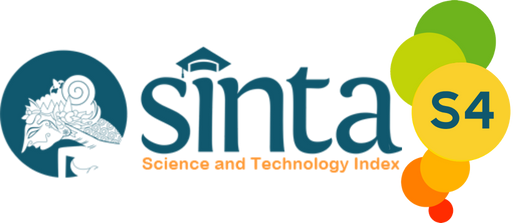Peran Gapoktan dalam Peningkatan Pendapatan Petani Tanaman Hias (Studi Kasus Gapoktan “Tani Makmur” Kecamatan Tawangmangu Kabupaten Karanganyar)
Abstract
Ornamental plants are cultivated or grown for their aesthetic value, including the beauty of their flowers, leaves, or the entire plant. These plants are commonly found in home gardens or yards. The development of ornamental plant farming requires the role of agricultural institutions. Agricultural institutions play crucial role in modernization of agriculture. This study aims to understand institutional system, the role of agricultural institutions, and the impact of the Tani Makmur Farmer Group Association on ornamental plant farmers in Nglurah Village. This research employs a qualitative method with a case study approach in Nglurah Village. Informants were selected using purposive and snowball sampling techniques. The study involved 14 informants, including farmers group association stakeholders, agricultural officers, and ornamental plant traders. Validity was ensured through source and method triangulation, and data were analyzed using the Miles and Huberman analysis method. The results showed that Nglurah Village has an institutional system that supports the sustainability of ornamental plant farming. Farmers group association in Nglurah Village has procedures, management, and roles. Farmers group association in Tawangmangu Sub-district plays various roles in developing ornamental plant farming, including acting as a liaison between farmer groups and the government, providing farming capital, offering information or facilitation to groups, and establishing partnerships with other business units. These roles have social impacts on farmers, such as improved relationships and harmony, as well as economic impacts, including easier access to capital. There is a need to enhance each institution to ensure that the management system operates more effectively and achieves the goals of the Tani Makmur Farmer Group Association.
Keywords
Full Text:
PDFReferences
Biddle, B. J. (2013). Role theory: Expectations, identities, and behaviors. New York: Academic press. Tersedia dari https://books.google.co.id/books?hl=id&lr=&id=oc5GBQAAQBAJ&oi=fnd&pg=PP1&dq=Role+theory:+Expectations,+identities,+and+behaviors&ots=m1ErKVDyq4&sig=FjHSO9NlyPHzT63OG0rKmAf_GV0&redir_esc=y#v=onepage&q=Role%20theory%3A%20Expectations%2C%20identities%2C%20and%20behaviors&f=false
Brown, L., LaFond, A., & Macintyre, K. (2001). Measuring capacity building, carolina population center. Chapel Hill: University of North Carolina at Chapel Hill.
De Jonge, A. (2015). Understanding attitudes towards gender diversity and affirmative action in China and India. The Glass Ceiling in Chinese and Indian Boardrooms, 119–138.
Esman, M. J. (1986). Unsur-unsur dari pembangunan lembaga dalam pembangunan lembaga dan pembangunan nasional: Dari konsep ke aplikasi. Editor J.W. Eaton. UI Press.
Faisal. (2022). Upaya Fungsi Gabungan Kelompok Tani (Gapoktan) Karya Mandiri Dalam Peningkatan Hasil Produksi Petani Padi Di Desa Seberang Pebenaan Kecamatan Keritang Kabupaten Indragiri Hilir. Riau: Universitas Islam Negeri Sultan Syarif Kasim. Tersedia dari https://repository.stai-tbh.ac.id/handle/123456789/364
Faisal, S. (2001). Metode Penelitian Sosial. Erlangga.
Fauzi, D. (2014). Peran kelembagaan dan kapasitas petani terhadap keberlanjutan usahatani (Studi Kasus di Desa Plumpungrejo Kecamatan Wonoasri Kabupaten Madiun), Doctoral dissertation. Malang: Universitas Brawijaya. Tersedia dari https://repository.ub.ac.id/id/eprint/107649/
Hermanto. (2017). Pengentasan kemiskinan di perdesaan: Pengembangan SDM, penguatan usaha, dan inovasi pertanian. Forum Penelitian Agro Ekonomi, 35(2), 139–150. Tersedia dari https://epublikasi.pertanian.go.id/berkala/fae/article/view/3521
Hutomo, A., & Agugng, S. (2023). Koperasi Tata Kelola dan Manajemen Pemberdayaan. Mafy Media Literasi.
Miles, M., Huberman, A., & Saldana, J. (2014). Qualitative data analysis, a methods sourcebook, Edition 3 Terjemahan. UI Press.
Morrison, T. (2001). Actoinable learning a handbook for capacity building through case based learning. ADB Institute.
Saragih, D. N., & Damanik, D. (2022). Pengaruh pendapatan dan konsumsi rumah tangga terhadap kesejahteraan petani jagung di Desa Mariah Bandar Kecamatan Pematang Bandar Kabupaten Simalungun. Jurnal Ekuilnomi, 4(2), 116–129. Tersedia dari https://jurnal.usi.ac.id/index.php/ekuilnomi/article/view/438
Setiawati, R., Heriana, I., Misda, S., & Mukhlis, M. (2022). Relasi makna antar kalimat pada berita Sindonews. com. Sajak: Jurnal Penelitian dan Pengabdian Sastra, Bahasa, dan Pendidikan, 1(3), 62–67. https://doi.org/10.25299/s.v1i3.9675
Soekartawi. (1994). Teori Ekonomi Produksi dengan Pokok Bahasan Analisis Fungsi Cobb-Douglas. PT Raja Grafindo Persada.
Sugiyono. (2022). Metode Penelitian Kualitatif. CV Alfa Beta.
Suradisastra, K. (2011). Revitalisasi kelembagaan untuk mempercepat pembangunan sektor pertanian dalam era otonomi daerah. Jurnal Pengembangan Inovasi Pertanian, 4(2), 2011.
Syahyuti. (2005). Pembangunan pertanian dengan pendekatan komunitas: kasus rancangan program prima tani. Forum Penelitian Agro Ekonomi, 23(2), 102–115. https://dx.doi.org/10.21082/fae.v23n2.2005.102-115
Uphoff, N. T. (1986). Local Institutional Development: An Analytical Sourcebook With Cases. Kumarian Press.
Wahyuni, L., Sugeng, R., & Andrean, E. (2022). Gerakan Literasi Agraris Penyuluhan Pertanian Berbasis Pemberdayaan. UB Press.
Refbacks
- There are currently no refbacks.






